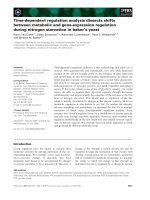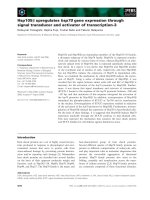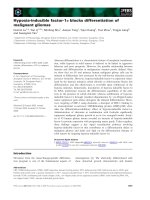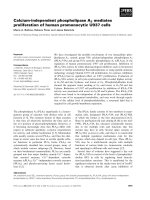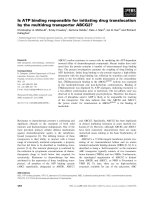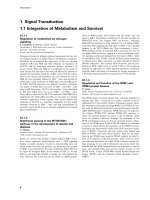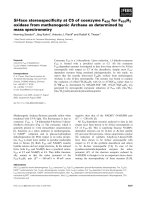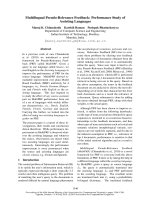Báo cáo khoa học: Fission yeast decaprenyl diphosphate synthase consists of Dps1 and the newly characterized Dlp1 protein in a novel heterotetrameric structure doc
Bạn đang xem bản rút gọn của tài liệu. Xem và tải ngay bản đầy đủ của tài liệu tại đây (387.83 KB, 9 trang )
Fission yeast decaprenyl diphosphate synthase consists
of Dps1 and the newly characterized Dlp1 protein in a novel
heterotetrameric structure
Ryoichi Saiki, Ai Nagata, Naonori Uchida, Tomohiro Kainou, Hideyuki Matsuda and Makoto Kawamukai
Department of Applied Bioscience and Biotechnology, Faculty of Life and Environmental Science, Shimane University, Matsue, Japan
The analysis of the structure and function of long chain-
producing polyprenyl diphosphate synthase, which syn-
thesizes the side chain of ubiquinone, has largely focused
on the prokaryotic enzymes, and little is known about the
eukaryotic counterparts. Here we show that decaprenyl
diphosphate synthase from Schizosaccharomyces pombe is
comprised of a novel protein named Dlp1 acting in part-
nership with Dps1. Dps1 is highly homologous to other
prenyl diphosphate synthases but Dlp1 shares only weak
homology with Dps1. We showed that the two proteins must
be present simultaneously in Escherichia coli transformants
before ubiquinone-10, which is produced by S. pombe but
not by E. coli, is generated. Furthermore, the two proteins
were shown to form a heterotetrameric complex. This is
unlike the prokaryotic counterparts, which are homodimers.
The deletion mutant of dlp1 lacked the enzymatic activity of
decaprenyl diphosphate synthase, did not produce ubiqui-
none-10 and had the typical ubiquinone-deficient S. pombe
phenotypes, namely hypersensitivity to hydrogen peroxide,
the need for antioxidants for growth on minimal medium
and an elevated production of H
2
S. Both the dps1 (formerly
dps)anddlp1 mutants could generate ubiquinone when they
were transformed with a bacterial decaprenyl diphosphate
synthase, which functions in its host as a homodimer. This
indicates that both dps1 and dlp1 are required for the
S. pombe enzymatic activity. Thus, decaprenyl diphosphate
from a eukaryotic origin has a heterotetrameric structure
that is not found in prokaryotes.
Keywords: Schizosaccharomyces pombe; decaprenyl diphos-
phate synthase; ubiquinone; CoenzymeQ.
Ubiquinone was identified initially as an essential factor
in aerobic growth and oxidative phosphorylation in the
electron transport system. Recently, however, multiple
additional functions of ubiquinone have been proposed.
One such function is its apparent role as a lipid-soluble
antioxidant that prevents the oxidative damage of lipids due
to peroxidation [1–4]. Studies using ubiquinone-deficient
yeast mutants also suggested that one of the in vivo functions
of ubiquinone is to protect against oxidants [5,6]. There is
also a proposed function that links between sulfide meta-
bolism and ubiquinone. Sulfide-ubiquinone oxidoreductase,
which was previously thought to occur mainly in photo-
biosynthetic bacteria, and which acts as a component in
an energy metabolic pathway, has now been shown to be
present in S. pombe and other eukaryotic organisms [7]. In
addition, the clk-1 mutant of Caenorhabditis elegans,which
has perturbed ubiquinone biosynthesis, shows a prolonged
life-span, suggesting a novel role of ubiquinone [8–11].
Furthermore, an elegant study showed that ubiquinone (or
menaquinone) accepts electrons that are generated by the
formation of protein disulfide in E. coli [12]. Thus, ubiqui-
none appears to play multiple roles.
The ubiquinone biosynthetic pathway is composed of
10 steps, including methylation, decarboxylation, hydroxy-
lation and isoprenoid transfer. The elucidation of this
pathway has mostly involved studying respiratory-defici-
ent mutants of E. coli and S. cerevisiae [13,14]. The length
of the isoprenoid side chain of ubiquinone varies between
organisms. For example, S. cerevisiae has ubiquinone-6,
E. coli has ubiquinone-8, rats and Arabidopsis thaliana
have ubiquinone-9, and humans and S. pombe have
ubiquinone-10. The length of the side chain appears to
be determined by polyprenyl diphosphate synthase, but not
by the 4-hydroxybenzoate-polyprenyl-diphosphate trans-
ferases, which catalyze the condensation of 4-hydroxy-
benzoate and polyprenyl diphosphate [15–17]. The basis
of this notion is that the heterologous expression in E. coli
and S. cerevisiae of polyprenyl diphosphate synthase
genes from other sources generated the same type of
ubiquinone as that expressed in the donor organisms. By
this method, Okada et al. successfully produced different
ubiquinone species (ubiquinone-5 to ubiquinone-10) in the
S. cerevisiae COQ1 mutant, which lacks its own poly-
prenyl diphosphate synthase [18]. Moreover, 4-hydroxy-
benzoate (PHB) polyprenyl diphosphate transferase was
confirmed to have a broad substrate specificity by the
heterologous expression of COQ2 in the ppt1D S. pombe
strain [19] and the ubiA-delta E. coli strain [20].
Correspondence to M. Kawamukai, Department of Applied Bioscience
and Biotechnology, Faculty of Life and Environmental Science,
Shimane University, 1060 Nishikawatsu, Matsue 690–8504, Japan.
Fax: + 81 852 32 6092, Tel.: + 81 852 32 6587,
E-mail:
Abbreviations: PHB, 4-hydroxybenzoate; GPP, geranyl diphosphate;
FPP, farnesyl diphosphate; GGPP, geranylgeranyl diphosphate;
IPP, isopentenyl diphosphate; GST, glutathione-S-transferase.
(Received 26 May 2003, revised 17 July 2003,
accepted 22 August 2003)
Eur. J. Biochem. 270, 4113–4121 (2003) Ó FEBS 2003 doi:10.1046/j.1432-1033.2003.03804.x
The genes encoding the short-chain polyprenyl diphos-
phate synthases, including geranyl diphosphate (GPP, C
10
)
synthase, farnesyl diphosphate (FPP, C
15
)synthaseand
geranylgeranyl diphosphate (GGPP, C
20
) synthase, have
been cloned from various organisms ranging from bacteria
to mammals [21–24]. The mechanisms that determine the
chain length synthesized by FPP synthase and GGPP
synthase have been extensively studied [25,26]. All of these
short-chain polyprenyl diphosphate synthases function as
homodimers, except for the GPP synthase from spearmint,
which functions as a heterotetramer [27,28]. In this latter
GPP synthase, one subunit is similar to known prenyl
diphosphate synthases but the other component does not
contain the typical aspartate-rich motifs that are considered
to be the substrate-binding sites. Unlike most of the short-
chain polyprenyl diphosphate synthases, the medium-chain
polyprenyl diphosphate synthases (C
30
and C
35
)thatare
responsible for synthesizing the side chain of the menaqui-
nones in Micrococcus luteus BP26, Bacillus stearothermo-
philus,andBacillus subtilis are heterodimers [29,30]. In
contrast, all the long-chain polyprenyl diphosphate synth-
ases that synthesize the ubiquinone side-chains are thought
to be homodimeric enzymes [14,21]. However, it has not
been known what kind of enzyme component(s) the
eukaryotic polyprenyl diphosphate synthase contains even
though its essential gene (e.g. COQ1 or dps1) has been
identified [6,31].
In this study, we characterized the decaprenyl diphos-
phate synthase of S. pombe. We found that the prenyl
diphosphate synthase homologue of S. pombe,Dps1,forms
a heterotetramer with another component that we identified
and denoted Dlp1. Dlp1 is needed to make a functional
enzyme as the dlp1 disruptant produced no ubiquinone, is
sensitive to H
2
O
2
and requires an antioxidant to grow on
glucose-containing medium, which is typical of the ubiqui-
none-deficient S. pombe strains [6,19]. This is the first
molecular characterization of a long chain-producing poly-
prenyl diphosphate synthase that synthesizes the side-chain
of ubiquinone in a eukaryote.
Materials and methods
Materials
Restriction enzymes and other DNA-modifying enzymes
were purchased from Takara Shuzo Co. Ltd. and New
England Biolabs, Inc. [1–
14
C]IPP (1.96 TBqÆmol
)1
)was
purchased from Amersham Pharmacia Biotech Ltd. IPP,
all-E-farnesyl diphosphate, geranylgeraniol, solanesol (all-
E-nonaprenol), and polyprenols (C
40
–C
60
)fromAilanthus
altissima were purchased from Sigma Chemical Co. Kiesel
gel 60 F
254
thin-layer plates were purchased from Merck.
Reverse-phase LKC-18 thin-layer plates were purchased
from Whatman Chemical Separation.
Strains and plasmids
E. coli strains DH10B and DH5a were used for the general
construction of plasmids [32]. Plasmids pBluescript SK+/–,
pT7Blue-T (Novagen), pSTV28 (Takara Shuzo), pQE31
(Qiagen), pGEX-KG (Amersham Pharmacia), pREP1 [33],
pREP2 (the LEU2 marker of pREP1 was exchanged with
the ura4 marker), pDS473 (ura4 marker), pDS472 (ura4
marker) and pSLF173 (LEU2 marker) were used as vectors
[34,35]. The S. pombe homothallic haploid wild-type
strain SP870 (h
90
leu1–32 ade6-M210 ura4-D18)andthe
diploid strain SP826 (h
+
leu1–32 ade6-M210 ura4-D18/h
+
leu1–32 ade6-M216 ura4-D18) [36] were used to pro-
duce Ddlp1::ura4 strains by homologous recombination.
KS10 (h
+
leu1–32 ade6-M216 ura4-D18 Ddps1::ura4)and
NU609 (h
90
leu1–32 ade6-M210 ura4-D18 Dppt1::ura4)
have been described previously [6,19]. Yeast cells were
grown in YE (0.5% yeast extract, 3% glucose) or PM
minimal medium with appropriate supplements as described
by Moreno et al. [37]. YEA and PMA contain 75 lgof
adenine per ml in YE and PM, respectively. The concen-
tration of the supplemented amino acids was 100 lgÆmL
)1
.
DNA manipulations
Cloning, restriction enzyme analysis, and preparation of
plasmid DNAs were performed essentially as described
previously [32]. The dlp1 gene was cloned and expressed in
E. coli and S. pombe as follows. Two oligonucleotides were
used to amplify the 1.8 kb fragment containing the dlp1
gene and the surrounding region, namely, 19G12X,
5¢-TCGAATTCGATGAGCTTTCCGTTC-3¢ (creates an
EcoRI site) and 19G12Y, 5¢-CATGGATATCGCATTC-3¢
(contains an EcoRV site). The resulting 1.8 kb fragment was
digested with EcoRI and EcoRV, cloned into the EcoRI-
SmaI sites of pSTV28 to yield pSTVDLP1 and the EcoRI-
EcoRV sites of pBluescript SK+ to yield pBSDLP1. To
make pDISDLP1, it was necessary to remove the BamHI
site of pBluescript SK+. After pBSDLP1 was digested with
NotIandSmaI, it was blunt-ended using the Klenow
Fragment (Takara Shuzo) and self-ligated. The resulting
plasmid was digested with BamHI and ligated with the ura4
cassette derived from pHSG398-ura4. Two other oligonu-
cleotides were also used to amplify the dlp1 gene, namely,
5-dlp1, 5¢-TCGTCGACGAGCTTTCCGTTC-3¢ (creates
a SalI site) and 3-dlp1, 5¢-TCCCCGGGATTACTTCG
AAAC-3¢ (creates a SmaI site). The amplified fragment was
cloned into the SalI-SmaI sites of pREP1 to yield pRDLP1.
To construct pGSTDLP1, the 5-dlp1Fu oligonucleotide
(5¢-TCGCGGCCGCATGAGCTTTCCG-3¢, which creates
a NotI site) and 3-dlp1 were used to amplify the dlp1 gene.
The amplified fragment was cloned into the NotIandSmaI
sites of pDS473 to yield pGSTDLP1. To construct
pGEXDLP1, pBSDLP1 was digested with SmaIandSalI
and then cloned into the SmaIandSalI sites of pGEX-KG
to yield pGEXDLP1.
To construct pBSDPS1, the oligonucleotides 5-dps1
(5¢-TCCTGCAGCATGATTCAGTATGTA-3¢, which cre-
ates a PstI site) and 3-dps1 (5¢-TCGTCGACTCACTTC
TTTCTCGTTAT-3¢, which creates a SalI site) were used to
amplify the dps1 gene. The plasmid pKS18 containing the
dps1 region from the S. pombe cDNA library was used as a
template for PCR. The amplified fragment was cloned into
the PstIandSalI sites of pBluescript SK+ to yield
pBSDPS1. To construct pHADPS1, the oligonucleotides
5-dps1Fu (5¢-TCGCGGCCGCATGATTCAGTAT-3¢,cre-
ates a NotIsite)and3-dps1wereusedtoamplifythedps1
region from the S. pombe cDNA library. The amplified
fragment was cloned into the NotIandSalIsitesof
4114 R. Saiki et al.(Eur. J. Biochem. 270) Ó FEBS 2003
pSLF173 to yield pHADPS1. To construct pSTVHI-
SDPS1, the oligonucleotides 5-Sph I-dps1 (5¢-GCGCATG
CGATGATTCAGTATGTA-3¢,createsaSphIsite)and
3-dps1 were used to amplify the dps1 gene. The plasmid
pBSDPS1 was used as a template for PCR. The amplified
fragment was cloned into the SphIandSalI sites of pQE31.
The pQE31 plasmid harboring the dps1 gene was digested
with XhoIandSalI and cloned into the Sal IsiteofpSTV28
to yield pSTVHISDPS1.
The ddsA gene that encodes the decaprenyl diphosphate
synthase of Gluconobacter suboxydans was endowed with
the putative mitochondrial transit sequences of the gene
encoding PHB polyprenyl diphosphate transferase (ppt1)as
follows. The mitochondrial transit sequences were amplified
by PCR using the oligonucleotides 5¢-AGGTCGACAGA
TTAGCATGTAAATAG-3¢ (creates a SalIsite)and
5¢-CGAAGCTTGGGGGTTACAGAGTTTGA-3¢ (cre-
ates a HindIII site). The PCR products were cloned into
the SalIandHindIII sites of pBluescript SK+ to yield
pBSTP. Two oligonucleotides, namely, 5-ddsA (5¢-GCA
AGCTTAAAGCTGTGGTTCAGGGTGCAG-3¢,creates
a HindIII site) and 3-ddsA (5¢-TAGCATGCTTAGCGGG
CCCGATTC-3¢,createsaSphI site), were used to amplify
the 1.0 kb fragment containing the ddsA gene and an
additional 23 amino acid segment beyond the first methio-
nine. The amplified fragment was then cloned into pT7Blue-
T to yield pT7DDSA. pT7DDSA was then digested with
HindIII and BamHI (this site was in pT7Blue-T) and cloned
into the HindIII and BamHI sites of pBSTP to yield
pBSTPDDSA. To construct pRDDSA, pBSTPDDSA was
digested with SalIandBamHI, and the fragment was cloned
into the SalIandBamHI sites of pREP1.
Gene disruption
The one-step gene disruption technique was performed
according to the procedure of Rothstein [38]. The
pDISDLP1 plasmid was linearized using the appropriate
restriction enzymes, and the linear plasmid was used to
transform SP826 for uracil prototrophy. Southern hybridi-
zation was performed as described previously [32].
Ubiquinone extraction and measurement
Ubiquinone was extracted as described previously [6,19].
The crude extract of ubiquinone was analyzed by normal-
phase TLC with authentic ubiquinone-10 as the standard.
Normal-phase TLC was carried out on a Kieselgel 60 F
254
plate with benzene/acetone (97 : 3, v/v). The band contain-
ing ubiquinone was collected from the TLC plate following
UV visualization and extracted with chloroform/methanol
(1 : 1, v/v). Samples were dried and redissolved in ethanol.
The purified ubiquinone was further analyzed by HPLC
with ethanol as the solvent.
Prenyl-diphosphate synthase assay and product analysis
Prenyl diphosphate synthase activity was measured by the
method described previously [15]. S. pombe cells were
grown on the mid-to-late log phase in PMA-based medium.
All subsequent steps were performed at 4 °C. Cells were
harvested by centrifugation, suspended in buffer A (100 m
M
potassium phosphate, pH 7.4, 5 m
M
EDTA, and 1 m
M
2-mercaptoethanol). The washed cells were ruptured by
vigorous shaking with glass beads 14 times for 30 s at 60 s
intervals in an ice bath. After centrifugation of the
homogenate, the supernatant was used as a crude enzyme
extract. The incubation mixture contained 2 m
M
MgCl
2
,
0.2% (w/v) Triton X-100, 50 m
M
potassium phosphate
buffer (pH 7.4), 5 m
M
KF, 10 m
M
iodoacetamide, 20 l
M
[
14
C]IPP (specific activity 0.92 MBqÆmol
)1
), 100 l
M
FPP,
and 1.5 mgÆmL
)1
protein of the enzyme in a final volume of
0.5mL.Thesamplemixtureswereincubatedfor60minat
30 °C. Reaction products, such as prenyl diphosphates,
were extracted with 1-butanol-saturated water and hydro-
lyzed with acid phosphatase. The hydrolysis products were
extracted with hexane and analyzed by reverse-phase TLC
with acetone/water (19 : 1, v/v). Radioactivity on the plate
was detected with a BAS1500-Mac imaging analyzer (Fuji
Film Co.). The plate was exposed to iodine vapor to detect
the spots of the marker prenols.
Immunoprecipitation of Dps1 protein with Dlp1 protein
To test whether Dlp1 and Dps1 form a heterologous
complex, pGSTDLP1, which produces the glutathione-S-
transferase (GST) and Dlp1 fusion protein, GST-Dlp1, and
pHADPS1, which produces HA-fused Dps1, were trans-
formed into S. pombe strain SP826. Transformants were
grown to the stationary phase in PMA medium and 0.5 mL
of culture was then inoculated into 50 mL of the same
medium. The cultures were grown to the mid-to-late log
phase. After the cells were collected by centrifugation at
3000 g for 5 min, the pellets were suspended in 0.1 mL of
buffer A. The suspended cells were ruptured by vigorous
shaking with glass beads 14 times for 10 s at 60 s intervals in
an ice bath. After the addition of 0.3 mL of buffer A kept at
4 °C, the homogenate was centrifuged at 2000 g for 5 min.
The supernatant solution was then mixed with glutathione
Sepharose 4B (Amersham Pharmacia Biotech) at 30 °Cfor
60 min. This mixture was washed five times with 140 m
M
NaCl, 2.7 m
M
KCl, 10 m
M
sodium phosphate and 1.8 m
M
potassium phosphate, and then once with 50 m
M
Tris/HCl
(pH 8.0) and 10 m
M
glutathione (glutathione elution buffer)
to elute the GST-Dlp1 protein. To detect Dps1-Dlp1
heterotetramers, a crude protein extract of E. coli harboring
pGEXDLP1 and pSTVHISDPS1 was incubated with the
water-insoluble cross linker disuccinimidyl suberate (Pierce)
(1 m
M
in final concentration) and subjected to Western
blotting.
Results
Cloning of the
dlp1
gene and construction
of the
dlp1D
strain
We hypothesized that the decaprenyl diphosphate synthase
of S. pombe might be a heteromeric enzyme because we
observed that expression of the dps1 gene alone in E. coli did
not give any enzymatic activity [6]. In contrast, when single
bacterial genes encoding prenyl diphosphate synthases are
expressed in E. coli, functional enzymes are produced
[16,39,40]. We looked for a potential partner of Dps1 by
searching the S. pombe genomic DNA sequence in the
Ó FEBS 2003 Decaprenyl diphosphate synthase from fission yeast (Eur. J. Biochem. 270) 4115
National Center for Biotechnology Information database
for a gene with homology to dps1. We found meaningful
sequence similarity with an uncharacterized gene
(SPAC19G12.12). The deduced amino acid sequence of
the SPAC19G12.12 gene possessed the conserved domains
I to VII of Dps1, but did not contain DDXXD sequence
motifs that are typically found in all prenyl diphosphate
synthases (Fig. 1). We designated this gene dlp1 (for D-less
polyprenyl diphosphate synthase) and characterized it
further.
Fig. 1. Alignment of the amino acid sequences of long chain-producing
polyprenyl diphosphate synthases. (1) Decaprenyl diphosphate synthase
encoded by ddsA from Gluconobacter suboxydans (NCBI accession no.
AB006850); (2) octaprenyl diphosphate synthase encoded by ispB from
E. coli (accession no. NP417654); (3) component of decaprenyl
diphosphate synthase encoded by dps1 from S. pombe (accession no.
D84311); (4) hexaprenyl diphosphate synthase encoded by COQ1 from
S. cerevisiae (accession no. J05547); (5) a novel component of deca-
prenyl diphosphate synthase encoded by dlp1 from S. pombe (acces-
sion no. AB118853). Residues conserved in more than two of the five
sequences are boxed. Conserved regions (I–VII) are underlined.
Numbers on the right indicate amino acid residue positions.
Fig. 2. Plasmid constructs used in this study and Southern hybridization
analysis of genomic DNAs from SP826, SP826Ddlp1 and RS312. (A)
Plasmid constructs. pRDDSA and pRDLP1 contain the entire length
of the ddsA and dlp1 genes, respectively. pHADPS1 and pGSTDLP1
express the HA–Dps1 and GST–Dlp1 fusion proteins, respectively.
pRDDSA, pRDLP1, pHADPS1 and pGSTDLP1 are under the
control of the strong nmt1 promoter. pGEXDLP1 contains the entire
length of the dlp1 genefusedwiththeGST gene in pGEX-KG vector.
pSTVHISDPS1 contains the entire length of the dps1 gene fused with
His
6
-tag that allows to express the His–Dps1 fusion protein in E. coli.
In pDISDLP1 the dlp1 gene was disrupted by the ura4 cassette on the
vector pBluescript SK+. (B) Southern hybridization analysis. (I)
Restriction map of the dlp1 and the dlp1::ura4 regions. Genomic
DNAs of wild-type and dlp1 disruptants were prepared, separated on
agarose gel, and probed with the ura4 gene (II) and the dlp1 gene from
pSTVDLP1 (III). Arrows and the size calculated from the sequences in
(I) matched with arrows indicated in (III). Lane 1, wild-type SP826
(diploid); lanes 2 and 3, SP826Ddlp1 (diploid); lane 4, RS312 (haploid).
TP: Transit peptide from P
p
+1 [19]. Ba, BamHI; EI, EcoRI; EV,
EcoRV; H, HindIII; N, NotI; P, PstI; Sa, SalI; Sp, SphI; Sm, SmaI; Xh,
XhoI.
4116 R. Saiki et al.(Eur. J. Biochem. 270) Ó FEBS 2003
To assess the relevance of the dlp1 gene in ubiquinone
biosynthesis, we constructed an S. pombe strain whose dlp1
gene has been disrupted (dlp1D). To do this, we constructed
the plasmid pDISDLP1, in which the dlp1 gene is disrupted
by the ura4 gene (Fig. 2A). This plasmid was then linearized
by the appropriate restriction enzymes and the fragment
was used to transform the S. pombe wild-type diploid strain
SP826. About 20 Ura
+
transformant colonies could be
picked and they were grown on YEA medium. After the
stability of the ura4
+
marker was examined by replica
plating, two stable Ura
+
transformants were obtained. One
of these strains, designated SP826Ddlp1, was allowed to
make spores, and the germinated haploid cells were plated
in replicates on plates containing YEA and PMA+Leu.
While all cells grew well on YEA medium, some grew only
very slowly on the PMA+Leu plate. One of these haploid
strains, designated RS312, and the parental diploid
SP826Ddlp1 strain were subjected to Southern hybridization
analysis to confirm the proper disruption of dlp1 by ura4
(Fig. 2B). RS312 (dlp1::ura4) was then examined for
ubiquinone synthesis as described in the Materials and
methods. No ubiquinone was detected in RS312, although
the RS312 strain that harbored the plasmid expressing dlp1
did show ubiquinone synthesis (Fig. 3). This encouraging
result indicates that the dlp1 gene is involved in ubiquinone
biosynthesis.
Phenotypes of the
dlp1
disruptant
It was reported previously that KS10 (Ddps1::ura4), a strain
of S. pombe whose decaprenyl diphosphate synthase-
encoding dps1 gene has been disrupted, and NU609
Fig. 3. Detection of ubiquinone-10 in S. pombe strains. Ubiquinone was
extracted from Wild-type SP870, KS10 (Ddps1::ura4), RS312
(Ddlp1::ura4), KS10 harboring pRDDSA or pRDPS1, and RS312
harboring pRDDSA or pRDLP1. Ubiquinone was first separated by
thin-layer chromatography and then further analyzed by high-pressure
liquid chromatography.
Fig. 4. Recovery of RS312 growth on minimal medium by adding cys-
teine or glutathione. (A) Wild-type SP870 harboring pREP2 (ura4
marker), NU609 (Dppt1::ura4), RS312 (Ddlp1::ura4) and RS312 har-
boring pRDLP1 were grown on PM medium supplemented with
75 lgÆmL
)1
adenine and 100 lgÆmL
)1
leucine. (B) The same strains
were grown on PM medium supplemented with adenine, leucine and
200 lgÆmL
)1
glutathione. (C) The same strains were grown as in B
except that cysteine was used instead of glutathione. NU609 and
RS312 could not grow on PM medium (A) unless it was supplemented
with glutathione (B) or cysteine (C). RS312 harboring pRDLP1 could
grow on PM medium lacking glutathione or cysteine (A).
Ó FEBS 2003 Decaprenyl diphosphate synthase from fission yeast (Eur. J. Biochem. 270) 4117
(Dppt1::ura4), a strain of S. pombe whose PHB polyprenyl
diphosphate transferase-encoding ppt1 gene has been
disrupted, are unable to produce ubiquinone and have
some notable additional phenotypes [6,19]. These include
H
2
O
2
and Cu
2+
sensitivity and a requirement of cysteine,
glutathione or a-tocopherol for growth on minimal medium
[19]. We thus tested RS312 for these phenotypes. RS312
(Ddlp1::ura4) was first grown on PM-based medium with
and without supplementation with 200 lgÆmL
)1
of cysteine
or glutathione. RS312 cells did not grow on the minimal
medium but the addition of cysteine or glutathione effect-
ively caused their growth to recover (Fig. 4). RS312 cell
growth also recovered when they were grown on minimal
medium containing 1 m
M
a-tocopherol, a well-known lipid
antioxidant (data not shown). In addition, the good growth
of RS312 on supplemented medium was severely inhibited
when 1 m
M
H
2
O
2
or 1 m
M
Cu
2+
was added (Fig. 5). Thus,
RS312 cells bear the same phenotypes as the ubiquinone-
nonproducers KS10 and NU609.
RS312 was similar to KS10 and NU609 in another
phenotype. We previously found that the S. pombe strains
that were deficient in either dps1 or ppt1 produced H
2
S but
the wild-type cells did not [6,19]. When we tested for the
presence of H
2
S by assaying for its chemical reaction with
lead acetate (which produces PbS), the RS312 culture was
found to produce H
2
S (data not shown). In addition, when
we measured the amount of acid-labile sulfide present in the
cells, we found that the ubiquinone-less mutants of RS312
(Ddlp1) and NU609 (Dppt1) produced 12-fold-higher
amounts of S
2–
(1064.9 and 1110.1 nmol per 10
9
cells,
respectively) than the wild-type strain SP870 (83.3 nmol per
10
9
cells). All these phenotypes of RS312 are identical to
those of the two ubiquinone-less mutants that had been
constructed earlier [6,19]. Thus, dlp1 is essential for ubi-
quinone synthesis in S. pombe.
Complementation of
dlp1
-disrupted cells by expressing
G. suboxydans ddsA
To determine whether dlp1 is directly involved in the
activity of decaprenyl diphosphate synthase, we expres-
sed ddsA in the dlp1 and dps1 disruptants. The ddsA
gene encodes the decaprenyl diphosphate synthase of
G. suboxydans.ThisddsA gene is known to be completely
functional when it is expressed in E. coli [40], which
suggests that DdsA is a homomeric enzyme. A 45 amino-
acid mitochondrial transfer signal from Ppt1, which is
known to locate in the mitochondria [19], was first added
to the ddsA gene product so that it would be located in
mitochondria. The resulting ppt1-ddsA fusion gene suc-
cessfully complemented both the dps1 and dlp1 disruptants
as both cell types were able to produce ubiquinone
(Fig. 3). Thus, the lack of ubiquinone synthesis in the dlp1
mutant,aswellasinthedps1 mutant, is due to the lack
of decaprenyl diphosphate synthase activity.
We further confirmed that the Ddlp1 strain, as well as
the dps1D strain, is defective in decaprenyl diphosphate
synthase activity by measuring the in vitro activity of this
enzyme as described in the materials and methods. Both
the Ddlp1 and Ddps1 strains did not produce decaprenol,
while the Dppt1 strain and wild-type retained their
activities (Fig. 6). However, when the Ddlp1 strain was
transfectedwiththeplasmidcontainingdlp1, the enzy-
matic activity was restored. Thus, both dlp1 and dps1 are
essential for decaprenyl diphosphate synthase activity in
S. pombe.
Fig. 5. Sensitivity of the ubiquinone-less mutant to oxygen radical pro-
ducers. Wild-type (circles) and RS312 (Ddlp1::ura4) (triangles) strains
werepregrownandthenplacedinfreshYEAmediumwith1 m
M
H
2
O
2
(A), 1 m
M
Cu
2+
(B) or neither. Cell numbers were counted at 4-h
intervals.
Fig. 6. Thin-layer chromatogram of the product of decaprenyl diphos-
phate synthase. The decaprenyl diphosphate synthase reactions of
KS10 (Ddps1::ura4, lane 1), RS312 (Ddlp1::ura4, lane 2), SP870 (Wild-
type, lane 3), NU609 (Dppt1::ura4, lane 4) and RS312 harboring
plasmid pRDLP1 (lane 5) were measured using [
14
C]IPPandFPPas
substrates. The products were hydrolyzed with phosphatase and the
resulting alcohols were analyzed by reverse-phase thin-layer chroma-
tography. The same amounts of radiolabeled products (5000 d.p.m.)
were applied to the TLC plate. The arrowhead indicates the position of
the synthesized decaprenols. The positions of standard alcohols
are indicated on the right: GGOH, all-E-geranylgeraniol; SOH,
all-E-solanesol; Ori., origin; S.F., solvent front.
4118 R. Saiki et al.(Eur. J. Biochem. 270) Ó FEBS 2003
Expression of
dps1
and
dlp1
in
E. coli
We speculated that if the dps1 and dlp1 are sufficient for
decaprenyl diphosphate synthase activity, cotransformation
of E. coli DH5a with the pSTVHISDPS1 plasmid that
expresses the dps1 gene and the pGEXDLP1 plasmid that
expresses the dlp1 gene may result in the formation of a
functional enzyme that generates the ubiquinone-10 species
that is produced by S. pombe. We found that while the
cells that were transformed only with pSTVHISDPS1 or
pGEXDLP1 produced only ubiquinone-8, which is syn-
thesized by the endogenous E. coli octaprenyl diphosphate
synthase, the pSTVHISDPS1 and pGEXDLP1 double
transformant produced a small amount of ubiquinone-10
Fig. 7. Detection of ubiquinone in E. coli
transfected with constructs expressing dlp1 and/
or dps1. Ubiquinone was extracted from
wild-type DH5a and DH5a harboring
pGEXDLP1 and/or pSTVHISDPS1.
Fig. 8. Tetrameric formation of Dlp1 and
Dps1. (A,B) Crude proteins were extracted
from SP826 harboring pHADPS1 and
pGSTDLP1 (lanes 1 and 3) or pHADPS1 and
pDS472 (lanes 2 and 4). The crude proteins
were incubated in buffer A at 30 °Cfor1h
and then purified by a GST column (lanes 1
and 2). Western blot analysis was performed
using an anti-HA (A) or anti-GST Ig (B).
Arrows indicate the positions of HA-Dps1 (A)
andGST-Dlp1(B)protein.TheasteriskinB
indicates the GST protein. (C,D) Crude
proteins were extracted from E. coli BL21
harboring pGEXDLP1 and pSTVHISDPS1
(lane 2). The crude proteins were incubated
with a cross-linker, disuccinimidyl suberate, at
30 °C for 30 min and then purified by a GST
column (lane 1). Western blot analysis was
performed using an anti-GST (C) or anti-His
Ig (D).
Ó FEBS 2003 Decaprenyl diphosphate synthase from fission yeast (Eur. J. Biochem. 270) 4119
(Fig. 7). This result indicates Dps1 and Dlp1 together form
a heteromeric decaprenyl diphosphate synthase.
Heterotetrameric formation of Dps1 and Dlp1
That dps1 and dlp1 are both required for the decaprenyl
diphosphate synthase activity suggests that Dps1 and Dlp1
might form a complex. Consequently, we tested whether
Dps1 and Dlp1 interact with each other to form a
heteromer. HA-linked Dps1 and GST-linked Dlp1 were
expressed together in S. pombe and subjected to pull-down
assays. When the GST–Dlp1 fusion was pulled down by the
GST-column, HA–Dps1 was coprecipitated, although when
HA–Dps1 was expressed with GST alone, HA–Dps1 was
not pulled down by the GST-column (Fig. 8A,B). Thus,
Dlp1andDps1bindtoeachotherinS. pombe.
To analyze the size of the Dps1–Dlp1 heteromer, we
prepared the crude proteins of E. coli expressing the GST–
Dlp1 and His–Dps1 fusion proteins and incubated them
with the protein crosslinker disuccinimidyl suberate. The
crosslinked proteins were then purified by a GST column
and subjected to SDS electrophoresis. Western blotting with
anti-GST and anti-His Igs detected a band with a molecular
mass near the marker of 175 kDa, which can be considered
to be a heterotetrameric molecule because the calculated
molecular mass of heterotetromeric GST–Dlp1 and His–
Dps1 is 188 kDa (Fig. 8C,D). Thus, wild-type Dlp1 and
Dps1 form a heterotetramer in E. coli.
Discussion
We identified a novel gene named dlp1 that encodes a
partner of Dps1, which together constitute the active
decaprenyl diphosphate synthase in S. pombe. The Dlp1
protein is weakly similar in sequence to Dps1 but lacks the
conserved regions of domains II and VI that are likely to be
the prenyl diphosphate synthase substrate-binding sites.
Dlp1 and Dps1 form a heterotetrameric complex in
S. pombe and together reconstitute ubiquinone-10-gener-
ating enzymatic activity in E. coli. The heterotetrameric
structure of Dps1 and Dlp1 is novel since other long
chain-producing polyprenyl diphosphate synthases that
synthesize the side chain of ubiquinone appear to exist as
homodimers [14,39]. That the S. pombe prenyl diphosphate
synthase exists as a heteromer, unlike its known homodi-
meric counterparts, may relate to the fact that the latter are
prokaryotic enzymes. In other words, eukaryotes may have
evolved heteromeric prenyl diphosphate synthases from the
homodimeric prokaryotic synthases. Supporting this notion
is our study with the homodimeric long chain-producing
polyprenyl diphosphate synthase from E. coli, namely, the
IspB octaprenyl diphosphate synthase [39]. Our group
previously showed that when E. coli is transfected with a
construct encoding a functionally inactive IspB molecule
due to a mutation, an active enzyme is nonetheless formed
when the mutant is paired with the wild-type enzyme [39].
This observation suggests that the components of the
homodimeric enzyme could be subjected to evolutionary
alteration wherein they act in a heteromeric form with
another molecule. At present, it is not clear whether this
heteromeric enzyme form occurs commonly in eukaryotes,
but our preliminary data do suggest that the human
decaprenyl diphosphate synthase is not a homomeric
enzyme (data not shown). Heteromeric prenyl diphosphate
synthases may be widely spread than it was thought as the
medium chain-producing heptaprenyl diphosphate synth-
ases from B. subtilis and M. luteus, which synthesize the
side-chain of menaquinone [29,30], do occur as hetero-
dimers and it was recently observed that the short chain-
producing geranyl diphosphate synthase from spearmint
forms a heterotetramer [27,28].
To date, we have obtained three ubiquinone-less
mutants of S. pombe due to the disruption of dps1, ppt1
and dlp1. All three mutants displayed essentially the same
phenotypes, namely sensitivity to H
2
O
2
and Cu
2+
,the
need for an antioxidant such as glutathione for growth on
minimal medium, and the production of H
2
S. The former
two phenotypes reflect the role ubiquinone plays as an
antioxidant, while the latter phenotype supports the
notion that ubiquinone acts as a sulfide oxidant. Unlike
S. pombe, ubiquinone-less S. cerevisiae do not produce
H
2
S. The lack of H
2
S production may be due to the fact
that, unlike S. pombe and other eukaryotes, S. cerevisiae
does not possess the genes encoding sulfide ubiquinone
reductase, which oxidizes sulfide by ubiquinone. Thus,
ubiquinone may play an common and important role in
eukaryotes by participating in a sulfide detoxication
pathway.
Acknowledgements
This work is supported by a Grant-in-Aid from the Ministry of
Education, Culture, Sports, Science and Technology of Japan. We
thank Asuka Honma for technical assistance.
References
1. Frei, B., Kim, M.C. & Ames, B.N. (1990) Ubiquinol-10 is an
effective lipid-soluble antioxidant at physiological concentrations.
Proc.NatlAcad.Sci.USA87, 4879–4883.
2. Witting, P., Pettersson, K., Letters, J. & Stocker, R. (2000) Anti-
atherogenic effect of coenzyme Q10 in apolipoprotein E gene
knockout mice. Free Radic. Biol. Med. 29, 295–305.
3. Ernster, L. & Dallner, G. (1995) Biochemical, physiological and
medical aspects of ubiquinone function. Biochim. Biophys. Acta
1271, 195–204.
4. Crane, F.L. (2001) Biochemical functions of coenzyme Q10.
J. Am. Coll. Nutr. 20, 591–598.
5. Do, T.Q., Schultz, J.R. & Clarke, C.F. (1996) Enhanced sensitivity
of ubiquinone-deficient mutants of Saccharomyces cerevisiae to
products of autoxidized polyunsaturated fatty acids. Proc. Natl
Acad. Sci. USA 93, 7534–7539.
6. Suzuki, K., Okada, K., Kamiya, Y., Zhu, X., Tanaka, K.,
Nakagawa, T., Kawamukai, M. & Matsuda, H. (1997) Analysis of
the decaprenyl diphoshate synthase (dps) gene in fission yeast
suggests a role of ubiquinone as an antioxidant. J. Biochem.
(Tokyo) 121, 496–505.
7. Vande Weghe, J.G. & Ow, D.W. (1999) A fission yeast gene for
mitochondrial sulfide oxidation. J. Biol. Chem. 274, 13250–13257.
8. Ewbank, J.J., Barnes, T.M., Lakowski, B., Lussier, M., Bussey, H.
& Hekimi, S. (1997) Structural and functional conservation of the
Caenorhabditis elegans timing gene clk-1. Science 275, 980–983.
9. Jonassen, T., Larsen, P.L. & Clarke, C.F. (2001) A dietary
source of coenzyme Q is essential for growth of long-lived
Caenorhabditis elegans clk-1 mutants. Proc. Natl Acad. Sci. USA
98, 421–426.
4120 R. Saiki et al.(Eur. J. Biochem. 270) Ó FEBS 2003
10. Branicky, R., Benard, C. & Hekimi, S. (2000) clk-1, mitochondria,
and physiological rates. Bioessays 22, 48–56.
11. Larsen, P.L. & Clarke, C.F. (2002) Extension of life-span in
Caenorhabditis elegans by a diet lacking coenzyme Q. Science 295,
120–123.
12. Bader, M., Muse, W., Ballou, D.P., Gassner, C. & Bardwell,
J.C.A. (1999) Oxidative protein folding is driven by the electron
transport system. Cell 98, 217–227.
13. Tzagoloff, A. & Dieckmann, C.L. (1990) PET genes of Saccharo-
myces cerevisiae. Microbiol. Rev. 54, 211–225.
14. Kawamukai, M. (2002) Biosynthesis, bioproduction and novel
roles of ubiquinone. J. Biosci. Bioeng. 94, 511–517.
15. Okada, K., Suzuki, K., Kamiya, Y., Zhu, X., Fujisaki, S.,
Nishimura, Y., Nishino, T., Nakagawa, T., Kawamukai, M. &
Matsuda, H. (1996) Polyprenyl diphosphate synthase essentially
defines the length of the side chain of ubiquinone. Biochim. Bio-
phys. Acta 1302, 217–223.
16. Okada, K., Kamiya, Y., Zhu, X., Suzuki, K., Tanaka, K.,
Nakagawa, T., Matsuda, H. & Kawamukai, M. (1997) Cloning of
the sdsA gene encoding solanesyl diphosphate synthase from
Rhodobacter capsulatus and its functional expression in Escher-
ichia coli and Saccharomyces cerevisiae. J. Bacteriol. 179, 5992–
5998.
17. Okada, K., Minehira, M., Zhu, X., Suzuki, K., Nakagawa, T.,
Matsuda, H. & Kawamukai, M. (1997) The ispB gene encoding
octaprenyl diphosphate synthase is essential for growth of
Escherichia coli. J. Bacteriol. 179, 3058–3060.
18. Okada, K., Kainou, T., Matsuda, H. & Kawamukai, M. (1998)
Biological significance of the side chain length of ubiquinone in
Saccharomyces cerevisiae. FEBS Lett. 431, 241–244.
19. Uchida, N., Suzuki, K., Saiki, R., Kainou, T., Tanaka, K.,
Matsuda, H. & Kawamukai, M. (2000) Phenotypes of fission yeast
defective in ubiquinone production due to disruption of the gene
for p-hydroxybenzoate polyprenyl diphosphate transferase.
J. Bacteriol. 182, 6933–6939.
20. Suzuki, K., Ueda, M., Yuasa, M., Nakagawa, T., Kawamukai, M.
& Matsuda, H. (1994) Evidence that E. coli ubiA product is
a functional homolog of yeast COQ2 and the regulation of
the ubiA gene expression. Biosci. Biotechnol. Biochem. 58, 1814–
1819.
21. Koyama, T. (1999) Molecular analysis of prenyl chain elongating
enzymes. Biosci. Biotechnol. Biochem. 63, 1671–1676.
22. Liang, P.H., Ko, T.P. & Wang, A.H. (2002) Structure, mechanism
and function of prenyltransferases. Eur. J. Biochem. 269, 3339–
3354.
23. Kainou, T., Kawamura, K., Tanaka, K., Matsuda, H. & Kawa-
mukai, M. (1999) Identification of the GGPS1 genes encoding
geranylgeranyl diphosphate synthases from mouse and human.
Biochim. Biophys. Acta 1437, 333–340.
24. Okada, K., Saito, T., Nakagawa, T., Kawamukai, M. & Kamiya,
Y. (2000) Five geranylgeranyl diphosphate synthases expressed in
different organs are localized into three subcellular compartments
in Arabidopsis. Plant Physiol. 122, 1045–1056.
25. Ohnuma, S., Hirooka, K., Tsuruoka, N., Yano, M., Ohto, C.,
Nakane, H. & Nishino, T. (1998) A pathway where polyprenyl
diphosphate elongates in prenyltransferase. Insight into a common
mechanism of chain length determination of prenyltransferases.
J. Biol. Chem. 273, 26705–26713.
26. Wang, K.C. & Ohnuma, S. (1999) Isoprenyl diphosphate syn-
thases. Trends Biochem. Sci. 24, 445–451.
27. Burke, C.C., Wildung, M.R. & Croteau, R. (1999) Geranyl
diphosphate synthase: cloning, expression, and characterization of
this prenyltransferase as a heterodimer. Proc. Natl Acad. Sci. USA
96, 13062–13067.
28. Burke, C.C. & Croteau, R. (2002) Interaction with the small
subunit of geranyl diphosphate synthase modifies the chain length
specificity of geranylgeranyl diphosphate synthase to produce
geranyl diphosphate. J. Biol. Chem. 277, 3141–3149.
29. Shimizu, N., Koyama, T. & Ogura, K. (1998) Molecular cloning,
expression, and characterization of the genes encoding the two
essential protein components of Micrococcus luteus B-P 26 hexa-
prenyl diphosphate synthase. J. Bacteriol. 180, 1578–1581.
30. Zhang, Y W., Koyama, T. & Ogura, K. (1997) Two cistrons
of the gerC operon of Bacillus subtilis encode the two subunits
of heptaprenyl diphosphate synthase. J. Bacteriol. 179, 1417–
1419.
31. Ashby, M.N. & Edwards, P.A. (1990) Elucidation of the defi-
ciency in two yeast coenzyme Q mutants. Characterization of the
structural gene encoding hexaprenyl pyrophosphate synthetase.
J. Biol. Chem. 265, 13157–13164.
32. Sambrook, J., Fritsch, E.F. & Maniatis, T. (1989) Molecular
Cloning: A Laboratory Manual, 2nd edn. Cold Spring Harbor
Laboratory Press, Cold Spring Harbor, NY.
33. Maundrell, K. (1993) Thiamine-repressible expression vectors
pREP and pRIP for fission yeast. Gene 123, 127–130.
34. Forsburg, S.L. & Sherman, D.A. (1997) General purpose tagging
vectors for fission yeast. Gene 191, 191–195.
35. Ozoe, F., Kurokawa, R., Kobayashi, Y., Jeong, H., Tanaka, K.,
Sen, K., Nakagawa, T., Matsuda, H. & Kawamukai, M. (2002)
The 14–3)3 proteins Rad24 and Rad25 negatively regulate Byr2
by affecting its localization in Schizosaccharomyces pombe. Mol.
Cell. Biol. 22, 7105–7109.
36. Kawamukai, M., Gerst, J., Field, J., Riggs, M., Rodgers, L.,
Wigler, M. & Young, D. (1992) Genetic and biochemical analysis
of the adenylyl cyclase-associated protein, cap. Schizosaccharo-
myces pombe. Mol. Biol. Cell. 3, 167–180.
37. Moreno, S., Klar, A. & Nurse, P. (1991) Molecular genetic ana-
lysis of fission yeast Schizosaccharomyces pombe. Methods
Enzymol. 194, 795–823.
38. Rothstein, R.J. (1983) One-step gene disruption in yeast. Methods
Enzymol. 101, 202–211.
39. Kainou, T., Okada, K., Suzuki, K., Nakagawa, T., Matsuda, H. &
Kawamukai, M. (2001) Dimer formation of octaprenyl diphos-
phate synthase (IspB) is essential for chain length determination of
ubiquinone. J. Biol. Chem. 276, 7876–7883.
40. Okada, K., Kainou, T., Tanaka, K., Nakagawa, T., Matsuda, H.
& Kawamukai, M. (1998) Molecular cloning and mutational
analysis of the ddsA gene encoding decaprenyl diphosphate syn-
thase from Gluconobacter suboxydans. Eur. J. Biochem. 255,
52–59.
Ó FEBS 2003 Decaprenyl diphosphate synthase from fission yeast (Eur. J. Biochem. 270) 4121

